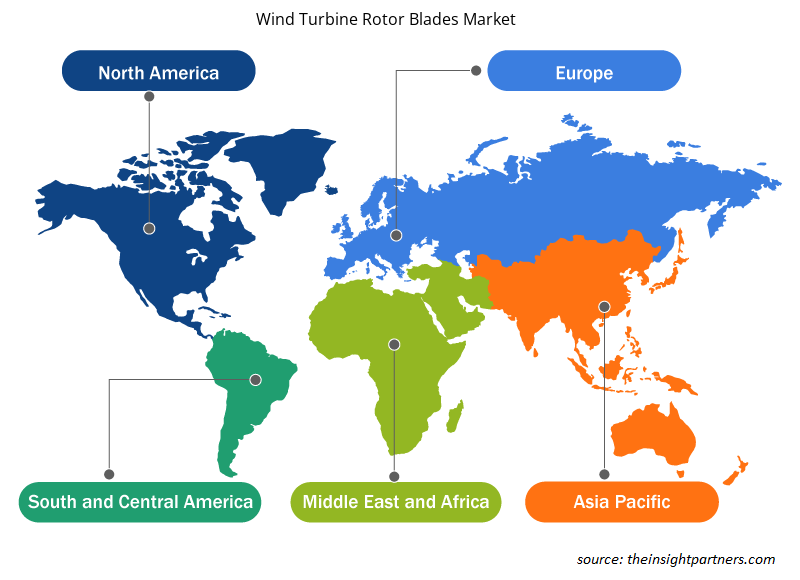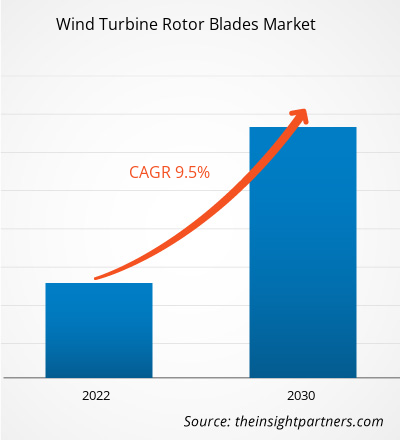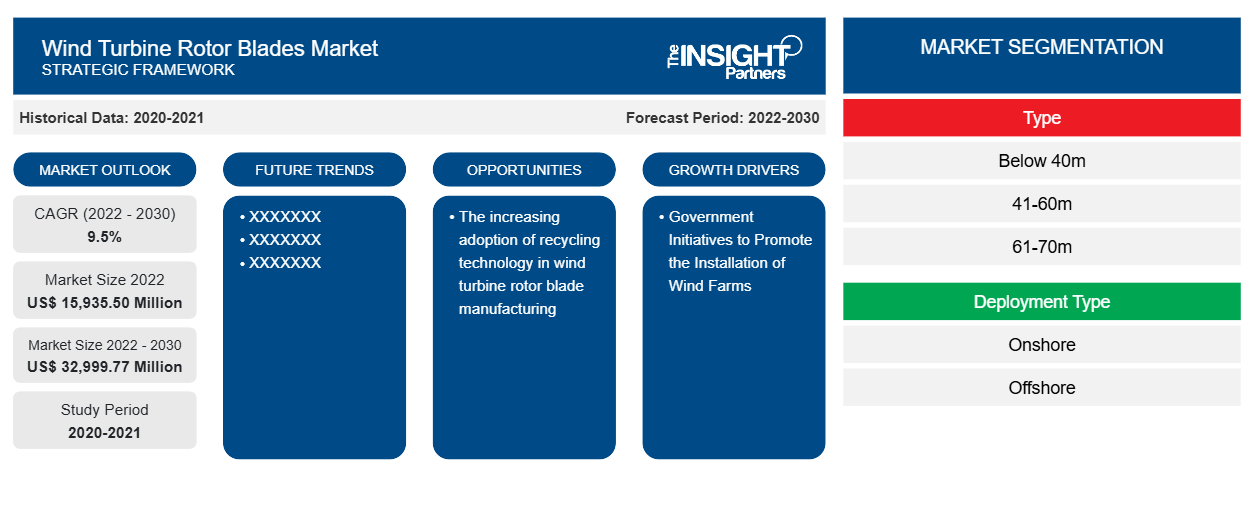2022 年风力涡轮机转子叶片市场价值为 159.355 亿美元,预计到 2030 年将达到 329.9977 亿美元;预计 2022-2030 年期间的复合年增长率为 9.5%。
风力涡轮机转子叶片制造中越来越多地采用回收技术可能会继续成为市场的主要趋势。
风力涡轮机叶片市场分析
由于陆上和海上风力发电项目数量不断增加,尤其是在偏远地区,预计风力涡轮机转子叶片市场将在分析的时间范围内经历显著增长。此外,政府通过专注于利用风能、太阳能、地热能等可再生能源发电来减少碳排放的法规预计将推动 2022 年至 2030 年的市场增长。此外,政府在全球范围内安装风力发电场的举措预计将在未来几年推动市场增长。
风力涡轮机转子叶片市场概况
随着人口和工业化的不断增长,全球对能源的需求也在不断增加。能源消耗的增加也推动了发展中国家和发达经济体对可再生能源发电的需求。这导致全球对风力发电基础设施的需求增加。与其他可再生能源相比,风力发电在世界范围内具有很高的重要性和可接受性。风力涡轮机转子叶片、涡轮机、基础、轴和其他部件的设计和开发技术的先进发展,促进了风能的采用和从可用风中获得最大功率的重大进步。根据国际可再生能源机构 (IRENA) 的数据,到 2023 年底,全球风电装机容量将从 2021 年的 825 吉瓦达到 1,017 吉瓦。因此,由于风能的优势以及优惠的政策、激励措施和退税,预计未来几年风电装机容量将增加。全球风电装机容量的这种增长预计将成为风力涡轮机转子叶片市场的主要驱动力。
定制此报告以满足您的需求
您可以免费定制任何报告,包括本报告的部分内容、国家级分析、Excel 数据包,以及为初创企业和大学提供优惠和折扣
-
获取此报告的关键市场趋势。这个免费样品将包括数据分析,从市场趋势到估计和预测。
风力涡轮机转子叶片市场驱动因素和机遇
政府采取措施推动风电场建设,以利于市场
预计各国政府在政策、补贴和投资方面对增加风能项目安装的支持将在分析的时间范围内推动风力涡轮机转子叶片市场的增长。印度政府正通过私营部门资助来推动该国风力发电厂的发展,提供各种财政和金融激励措施,如加速折旧福利和对风力发电机某些部件的优惠关税或免税。例如,德国正计划提出一项法案来加速风能扩张。新法律将对联邦州的陆上风能扩张实施具有约束力的区域目标。2022 年 4 月,德国计划在一项名为“复活节一揽子计划”的历史性一揽子计划的帮助下,从 2025 年开始将海上风电目标部署到每年 10 吉瓦以上,这是德国能源政策最深刻的一系列变化。在这些政府举措的帮助下,到 2030 年,德国 80% 的电力需求将由可再生能源电力满足。全球各地政府为推动风电场的安装而采取的此类举措预计将推动 2022 年至 2030 年期间的市场增长。
浮动风电技术日益受到关注
浮动风电技术是将海上风力涡轮机安装在海上浮动结构上,以确保涡轮机在深水中发电。浮动或海上风电技术在恶劣的环境条件下效率很高,因此能够产生巨大的电力。这种浮动风电技术在全球多个国家采用,例如中国、德国、日本、英国、法国、比利时和丹麦。浮动风电技术应用的增长前景主要归因于技术进步、相关优势以及各种服务提供商提供的交钥匙解决方案的增加。各国对实现清洁能源目标的认识不断提高,推动了对浮动海上风电的需求,这为风力涡轮机转子叶片市场的增长带来了潜在机会。
《浮动海上风电卓越中心》报告确定了 22 个最有可能成为新兴可再生能源技术主要参与者的国家。例如,2023 年,总部位于英国的 Octopus Energy 宣布计划到 2030 年在海上风电领域投资 200 亿美元。2023 年,美国政府批准了第四个海上风电项目。这一声明标志着美国向到 2030 年部署 30 千兆吨 (GW) 海上风电容量的目标又迈进了一步。此外,2022 年 1 月,英国政府宣布了 11 个可再生能源项目,每个项目将获得高达 9.5923 亿美元的奖励,因为它提出了 29.7 亿美元来促进英国的可再生能源发电。预计全球对海上或浮动风电技术的此类投资将在未来几年推动市场增长。
风力涡轮机转子叶片市场报告细分分析
风力涡轮机转子叶片市场分析的关键部分包括类型和应用
- 根据类型,风力涡轮机转子叶片市场分为 40 米以下、41-60 米、61-70 米和 70 米以上。2022 年,70 米以上部分占据了最大的市场份额。
- 根据应用,市场分为陆上和海上。2022 年,陆上部分占据了更大的市场份额。
风力涡轮机转子叶片市场份额按地区分析
风力涡轮机转子叶片市场报告的地理范围主要分为五个区域:北美、亚太、欧洲、中东和非洲、南美和中美。
2022 年,亚太地区占据了风力涡轮机转子叶片市场的主导地位。亚太地区包括中国、澳大利亚、印度、韩国、日本和亚太地区其他地区。2022 年,亚太地区在全球风力涡轮机转子叶片市场中占据第二大市场份额,预计在预测期内将以最快的复合年增长率扩张。强劲的陆上行业和该地区大量风力涡轮机转子叶片制造商的存在是其高市场份额的原因。此外,中国、日本、韩国和东南亚不断扩大的海上行业正在推动该地区风力涡轮机转子叶片供应商的市场。此外,该地区对陆上和海上风电场安装的投资增加预计将推动 2022 年至 2030 年对风力涡轮机转子叶片的需求。
风力涡轮机转子叶片市场区域洞察
Insight Partners 的分析师已详尽解释了预测期内影响风力涡轮机转子叶片市场的区域趋势和因素。本节还讨论了北美、欧洲、亚太地区、中东和非洲以及南美和中美洲的风力涡轮机转子叶片市场细分和地理位置。

- 获取风力涡轮机转子叶片市场的区域特定数据
风力涡轮机转子叶片市场报告范围
| 报告属性 | 细节 |
|---|---|
| 2022 年市场规模 | 159.355 亿美元 |
| 2030 年市场规模 | 329.9977亿美元 |
| 全球复合年增长率(2022 - 2030 年) | 9.5% |
| 史料 | 2020-2021 |
| 预测期 | 2022-2030 |
| 涵盖的领域 |
按类型
|
| 覆盖地区和国家 |
北美
|
| 市场领导者和主要公司简介 |
|
风力涡轮机转子叶片市场参与者密度:了解其对业务动态的影响
风力涡轮机转子叶片市场正在快速增长,这得益于终端用户需求的不断增长,而这些需求又源于消费者偏好的不断变化、技术进步以及对产品优势的认识不断提高等因素。随着需求的增加,企业正在扩大其产品范围,进行创新以满足消费者的需求,并利用新兴趋势,从而进一步推动市场增长。
市场参与者密度是指在特定市场或行业内运营的企业或公司的分布情况。它表明相对于给定市场空间的规模或总市场价值,有多少竞争对手(市场参与者)存在于该市场空间中。
在风力涡轮机转子叶片市场运营的主要公司有:
- TPI复合材料公司
- 维斯塔斯风力发电系统有限公司
- 德国能源控制公司
- LM 风力发电公司
- 西门子歌美飒可再生能源
- 南非
免责声明:上面列出的公司没有按照任何特定顺序排列。

- 了解风力涡轮机转子叶片市场的主要参与者概况
风力涡轮机转子叶片市场新闻和最新发展
风力涡轮机转子叶片市场通过收集一手和二手研究后的定性和定量数据进行评估,其中包括重要的公司出版物、协会数据和数据库。风力涡轮机转子叶片市场的一些发展情况如下:
- TPI Composites, Inc. (TPI) 是一家致力于提供创新和可持续解决方案以实现世界脱碳和电气化的公司,该公司宣布将与 GE 可再生能源 (GE) 的供应协议延长至 2025 年。通用电气和 TPI Composites, Inc 计划合作开发 GE 的下一代叶片类型,包括在 2023 年增加更多生产设施,以补充 GE 与 TPI 合作运营的 9 个生产设施。(来源:TPI Composites, Inc.,新闻稿,2023 年 1 月)
- 西门子歌美飒可再生能源公司宣布最终收购 Ria Blades, SA,该公司从事位于葡萄牙 Vagos 的陆上风力涡轮机叶片生产设施的运营,以及工厂运营所需的其他额外资产。(来源:西门子歌美飒可再生能源公司,新闻稿,2023 年 4 月)
风力涡轮机转子叶片市场报告覆盖范围和交付成果
“风力涡轮机转子叶片市场规模和预测(2020-2030 年)”报告对以下领域进行了详细的市场分析:
- 风力涡轮机转子叶片市场规模及全球、区域和国家层面所有主要细分市场的预测
- 风力涡轮机转子叶片的市场趋势以及市场动态,如驱动因素、限制因素和关键机遇
- 详细的 PEST 和 SWOT 分析
- 风力涡轮机转子叶片市场分析涵盖主要市场趋势、全球和区域框架、主要参与者、法规和最新市场发展
- 行业格局和竞争分析,涵盖市场集中度、热点图分析、知名企业以及风力涡轮机转子叶片市场的最新发展
- 详细的公司简介
- 历史分析(2 年)、基准年、预测(7 年)及复合年增长率
- PEST和SWOT分析
- 市场规模、价值/数量 - 全球、区域、国家
- 行业和竞争格局
- Excel 数据集
近期报告
相关报告
客户评价
购买理由
- 明智的决策
- 了解市场动态
- 竞争分析
- 客户洞察
- 市场预测
- 风险规避
- 战略规划
- 投资论证
- 识别新兴市场
- 优化营销策略
- 提升运营效率
- 顺应监管趋势























 获取免费样品 - 风力涡轮机转子叶片市场
获取免费样品 - 风力涡轮机转子叶片市场